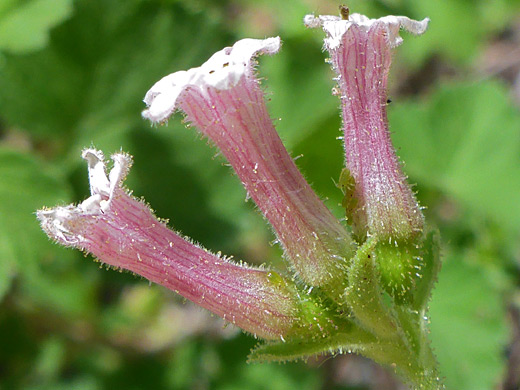Common name:
Wax currant
Family:
Scientific name:
Ribes cereum
Main flower color:
Range:
The Rocky Mountain states and all states to the west
Height:
Up to 6 feet
Habitat:
Canyons, open woodland, rocky hillsides and cliffs, from 300 to 13,000 feet
Leaves:
Rounded to kidney-shaped, around 1 inch across, shallowly divided into 3 or 5 lobes. Round-toothed
Season:
April to August
The common name of ribes cereum, wax currant, refers to the leaves, which have a covering of short, glandular hairs, secreting a waxy oil. The glands may be stalked or sessile. Leaves are shallowly lobed, lined with coarse, rounded teeth, on stalks about equal in length to the blade. The greyish stems are also glandular (the glands are stalked), and spreading; they lack spines.
The pendent flowers may be solitary or in groups of up to eight, in a tight cluster at the tip of the glandular stalk, attached by very short pedicels, subtended by bracts. Flowers are formed of a pinkish white tube (the hypanthium), with darker pink veins, topped by five small petals. The five stamens are included within the tube. Anthers are yellow. Fruits are egg-shaped berries, orange to red.
Plants in most regions are var cereum, with rounded bract tips and stalked glands on the sepals; var colubrinum of the Pacific Northwest has pointed bracts, and lacks stalked glands on the sepals.
The pendent flowers may be solitary or in groups of up to eight, in a tight cluster at the tip of the glandular stalk, attached by very short pedicels, subtended by bracts. Flowers are formed of a pinkish white tube (the hypanthium), with darker pink veins, topped by five small petals. The five stamens are included within the tube. Anthers are yellow. Fruits are egg-shaped berries, orange to red.
Plants in most regions are var cereum, with rounded bract tips and stalked glands on the sepals; var colubrinum of the Pacific Northwest has pointed bracts, and lacks stalked glands on the sepals.
All Contents © Copyright The American Southwest | Comments and Questions | Contribute | Site Map




